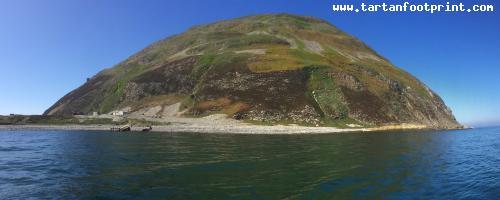You seem to be using an older version of Internet Explorer. This site requires Internet Explorer 8 or higher. Update your browser here today to fully enjoy all the marvels of this site.
June 7, 2018 by Alexander Meldrum
Alisa craig
Ailsa Craig (/'e?ls?/; Scottish Gaelic: Creag Ealasaid) is an island of 99 hectares (240 acres) in the outer Firth of Clyde, 16 kilometres (10 miles) west of mainland Scotland, upon whi...Alisa craig
Ailsa Craig (/'e?ls?/; Scottish Gaelic: Creag Ealasaid) is an island of 99 hectares (240 acres) in the outer Firth of Clyde, 16 kilometres (10 miles) west of mainland Scotland, upon which blue hone granite has long been quarried to make curling stones.
The now uninhabited island is formed from the volcanic plug of an extinct volcano.
The island, colloquially known as "Paddy's milestone", was a haven for Catholics during the Scottish Reformation in the 16th century, but is today a bird sanctuary, providing a home for huge numbers of gannets and an increasing number of puffins.
The island was owned by David, Marquess of Ailsa until 2013, when it was bought by a British conservation trust.
Curling stones
From the mid-nineteenth century the island has been quarried for its rare type of micro-granite with riebeckite (known as "Ailsite"), which is used to make stones for the sport of curling.
As of 2004, 60–70% of all curling stones in use were made from granite from the island and it is one of only two sources for all stones in the sport, the other being the Trefor Granite Quarry in Wales.
Ailsa Craig produced two types of granite for curling, Blue Hone and Ailsa Craig Common Green. Blue Hone has very low water absorption, which prevents the action of repeatedly freezing water from eroding the stone.
Ailsa Craig Common Green is a lesser quality granite than Blue Hone. In the past, most curling stones were made from Blue Hone but the quarry is restricted by environmental conditions that exclude blasting.
Kays of Scotland has been making curling stones since 1851 and has the exclusive rights to the Ailsa Craig granite, granted by the Marquess of Ailsa.
The last "harvest" of Ailsa Craig granite by Kays took place in 2013, after a hiatus of 11 years; 2,000 tonnes were harvested, sufficient to fill anticipated orders until at least 2020.
History
In 1590 the shipping of the Clyde was disrupted by pirates who were said to be Highlanders, quha lyis about Ailsay.
In 1831, The 12th Earl of Cassilis became first Marquess of Ailsa, taking the title from the Craig, which was his property.
An annual hunt of the solan geese or gannets took place in the days of Robert Burns as the flesh was considered a delicacy. Robert Burns' maternal uncle, Samuel Burns was involved in the solan goose trade.
Ailsa Castle
The 12-metre (39 ft) high ruins of a 3-storey castle that stands on the eastern side of the island was built in the late 1500s by the Hamilton Family to protect the island from King Philip II of Spain.
The island was used as a prison during the 18th and 19th centuries. The castle has two vaulted storeys and an oven is located in a cellar with evidence of a spiral stairway that once ran to the top of the tower.
Three cinquefoils arranged in a 'V' shape are carved on the tower and indicate that the Hamiltons were linked with the structure. There are indications of an adjoining building that ran to the north.
Smuggling
Beneath the Main Craig at the southern end of the island and 40 ft (12m) above sea level is a cave named after the supposed smuggler MacNall.
When the cave was being cleared of guano many years ago two stone coffins were found, both containing human bones.
The Rev. Roderick Lawson (1831–1907) thought that one of the interments might be MacNall himself, but no details of this individual have yet come to light.
Ailsa Craig would have been an ideal place for the temporary hiding of contraband goods.
The Lighthouse was built between 1883 and 1886 by Thomas Stevenson; it is owned by the Northern Lighthouse Board.
Railways
Ailsa Craig had two quite separate rail transport systems, one dated from 1886 and supplied coal, oil fuel and provisions to the lighthouse and gas works via the North Port and later the New Jetty
and the other transported road stone from the quarries at Kennedy's Nags via the stone crusher to the Quarry Pier.
The Northern Lighthouse Board's tramway had a section worked via a powered cable way that hauled wagons up from the North Port and later from the New jetty.
Bird Sanctuary,
The island is now a bird sanctuary, leased by the RSPB until 2050 and has Huge numbers of gannets nest here.
For more facts go to Wikipedia.
In this photo:


 Elizabeth Flintoff likes this.
Elizabeth Flintoff likes this.